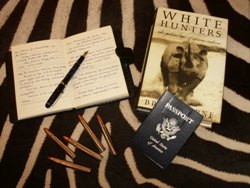

 The Accurate Reloading Forums
The Accurate Reloading Forums  THE ACCURATE RELOADING.COM FORUMS
THE ACCURATE RELOADING.COM FORUMS  Hunting
Hunting  Hunting Reports - Africa
Hunting Reports - Africa  Natal to Zambezi to Limpopo
Natal to Zambezi to LimpopoGo  | New  | Find  | Notify  | Tools  | Reply  |  |
| One of Us |
Put together this for an e-mail to family and friends as well as a hunt report. Some of those getting it by e-mail aren't that familiar with African hunting so bear that in mind as you read it. That's also the reason for the pictures of all the amenities at the various camps and lodges. This is also part 1, more to follow South Africa and Zimbabwe 2008 In all of life and especially in safari hunting one has to be prepared for change. Game laws change, countries undergo revolutions/civil wars often resulting in name changes, and some even close to hunting with little or no notice like Kenya and Tanzania in1978. Changes are sometimes for the better like Mozambique’s recovery after a long civil war. With change comes opportunity; like how the safari industry shifted south with the closure of East Africa. If there is a running theme to this adventure of mine it is change, and learning to deal with it. I first started planning and saving for this trip in 2006. In fact I think I had the seed of an idea planted in my mind during my Namibia safari in ’05. I planned on making it a family trip; a graduation present for my step-daughter. The animals I was particularly after were bushbuck, nyala, and buffalo. I looked around for various outfitters and finally found one that looked like he could get that set up. Stephen Barber of Xomaqua Lodge. Because the girls were coming along there were requirements for amenities that would not be there if it was just me. The outfitter suggested a 3 day trip to Kruger Park as well, and I agreed that it would be a great idea. We were originally planning 5 days in Zim for buffalo only (this plan was being formulated in the twilight of the 5 day buffalo hunts), and 4 days in RSA for bushbuck and nyala, plus 3 days of Kruger. That’s when the changes started happening. My wife realized that she couldn’t handle the flight about a year ahead of time. She does have ear problems, and after a flight to Jamaica it took her 3 days to get over it. That meant the girls weren’t coming. I contacted Stephen about this and let him know about a year in advance. The first change was the timing; we had previously set a general time for the hunt, but not specific dates. With the girls not going there was more flexibility for me. Dates were finally arranged, and at this time I found out that the hunt would be in Sapi or Nyakasanga. As it turns out, his deal originally planned in the Save fell through, so he purchased some of the Zim auction hunts. The previous client decided that he was more interested in a leopard than a hippo, so one became available for me. I wasn’t interested in nor was I budgeting for that, and even on the flight over I still had no intention of hippo hunting. I finalized my plans, flights, etc and finally left on July 12. Other than having a fat woman spilling over into my seat (the arm rest would not go down) the flight over was uneventful. I must say that even with her beside me, I felt like I had more room in Delta’s 767 than in SAA’s airbus. I was collected at OR Tambo, and got through SAPS without much hassle. Shortly after that we were off on a five hour road trip in the dark to Mavela camp in Natal near Mkuze. We finally arrived around midnight, and after a quick shower (my first in 30 hrs) it was off to bed for a few hours sleep. Mavela is set up as a permanent tent camp. The tents have concrete floors, and en-suite facilities with hot and cold running water, and real beds as opposed to cots. Sleep came easily, and morning came quickly. After a leisurely breakfast the scope’s zero was checked at the range, and we were off. 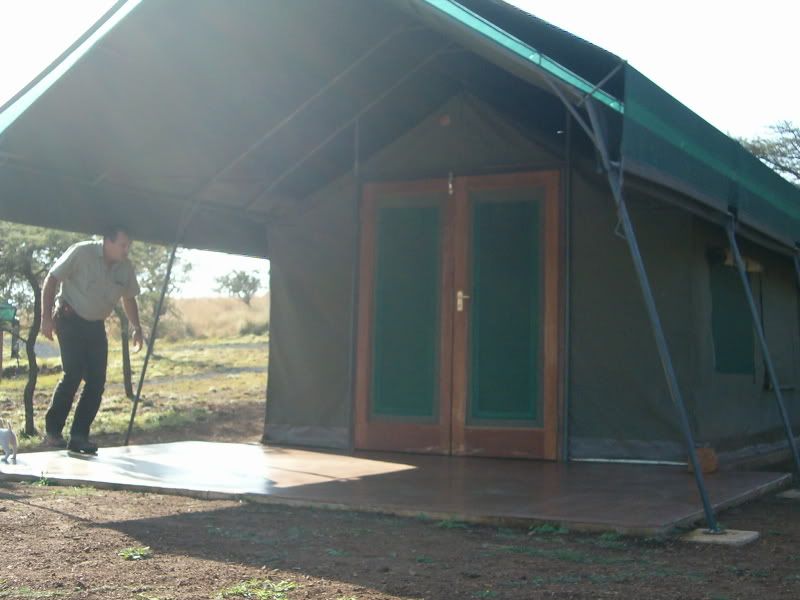 Stepehn in front of my tent. 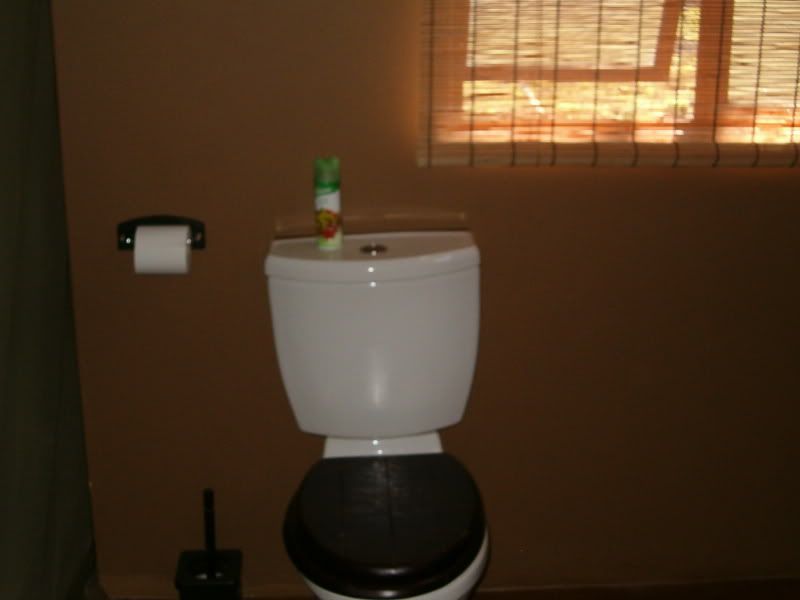 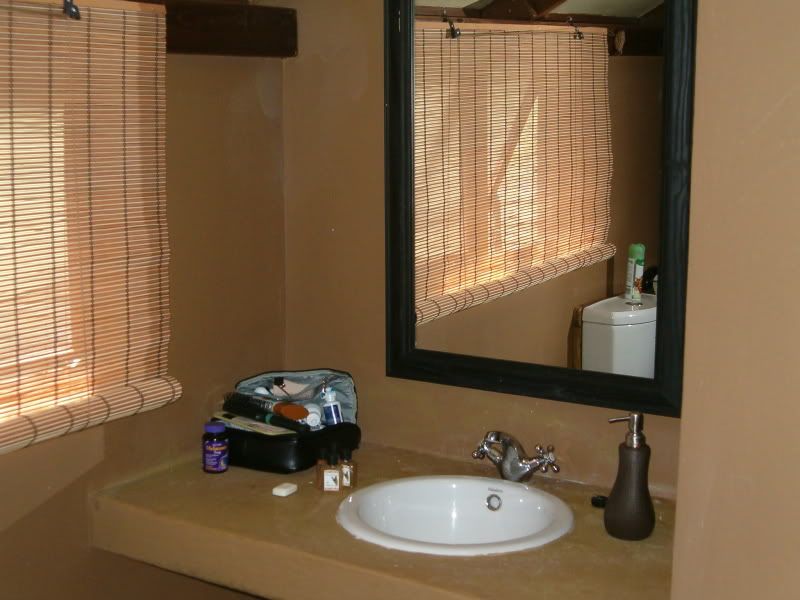 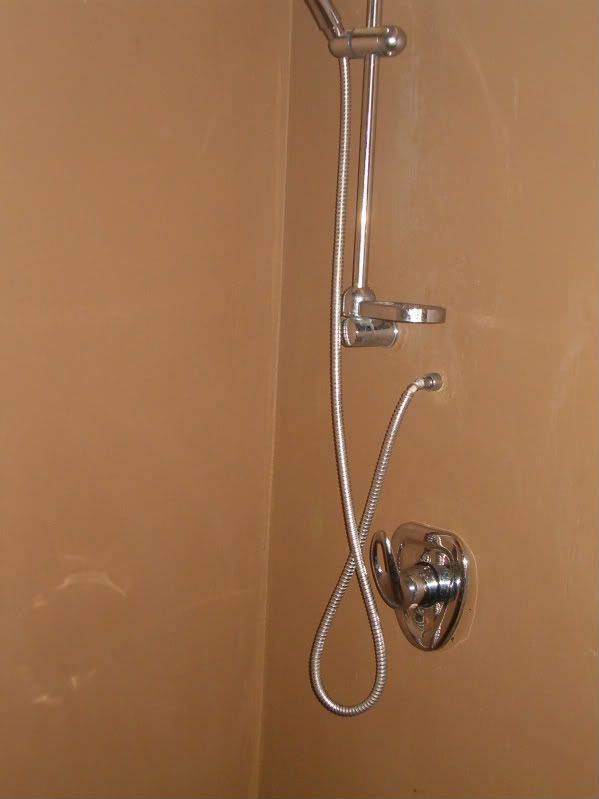 Due to some confusion on the timing of my arrival a PH had been arranged for me at Mavela. My PH would be Charles Humphries of Zululand Hunters. Charles is in his early twenties, and is well on his way to becoming an extremely fine professional hunter. We started out from camp scouting for nyala. It quickly became evident that this area is teeming with them. There were some areas where nyala seemed to be hiding behind every bush. The only thing more prevalent was warthog. We drove all morning trying to find a good one, but all that looked like shooters still had some ginger on the forehead. Eventually we saw one worth chasing to at least get a better view of his horns, so it was off of the truck and into the Natal bush. We started a stalk, but less than 30 minutes later we saw how “the shifty one†earned his name. Back to the truck through all the brush and vines we went. We drove around some more until late morning when we stalked through a riverbed; again young bulls, cows and warthogs were the main animals seen. At least one red duiker was spotted along the way. Eventually we gave up for the morning and headed back to camp for lunch. Mavela is one of five or six properties which comprise a rhino reserve. The agreement between the landowners is to take down all of the interior fences and turn it into one larger area. Not all of the landowners allow hunting, and at least one landowner is being a little slow lowering his fences. Both black and white rhino are present here, and I was a bit disappointed that neither was seen during my stay there. On the way back to Mavela we finally saw a shooter bull, unfortunately he was on the property of the only non-hunting property of the reserve. The bull must have known he was safe because he just paid no attention to us only mere feet away from us in the truck. On the way back out after lunch a similar thing happened, only this time it was a bachelor herd of three. One had some impressive horns, but just below these was a spot of ginger. We concentrated on dry riverbeds planning to walk through them, but before we made it to our planned starting point; we saw a good one on the opposite bank. Out of the car and the stalk began. He spotted us and moved into some thick stuff. We moved a little to the side waiting for him to come into an opening, but he never came out. While making game plans, suddenly he appeared back where we had first seen him; he’d doubled back on us. With a little quick backtracking we were able to get the sticks up and he stopped just long enough for me to get a shot off, quartering away. He quickly disappeared, but I felt good about the shot. We then went down the twenty foot or so bank, and found a place to go up the other bank. We fought and cut our way through the thorn and vines to the clearing where the nyala was when I took my shot, before blood was found we heard movement in the bush. Stephen told me to be ready for a finisher shot, but I had a good feeling about that sound. Charles led the way, looking for blood to follow, but before he found blood, he found the nyala. It took at least 5 minutes for us to make the 20 or so yards the nyala traveled before dying. My first animal with my 375, and my first animal with my own loads. Now we had to figure out how to get him out, turned out to not be so hard after all. The bakkie was brought through the riverbed to our location, and a rope was thrown up. We carefully lowered the nyala down and positioned him for the pictures. I was very pleased with the results. Charles later measured it for me because I knew people would ask; then I had to ask him “What size do hunters say they want?†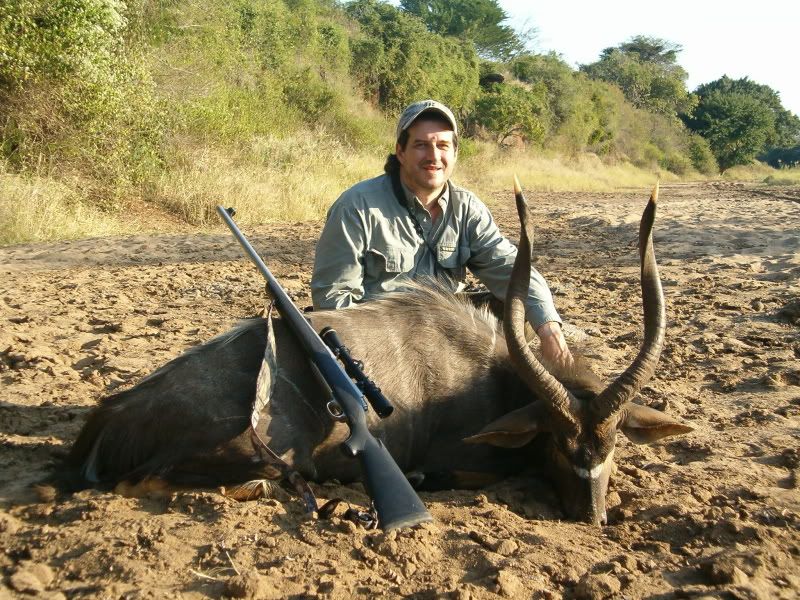 My nyala I feel privileged to have hunted with Charles. He seems to have the skills, and definitely the personality to be a good PH. When I gave him the “$50 handshake†I could see his eyes light up, and he still simply slid it into his pocket without looking to see how much it was. Anyone reading this should keep an eye out for his name in the future. If he has the business sense I think he could really become a big name in the safari hunting world. That night around the fire I remembered a Sports Afield article I had read just before leaving. In the article Kevin “Doctari†Robertson discussed seeing a dagga boy in the coals of a fire, and then encountering one the next day. As I looked in the coals I could see a hippo’s head and announced that according to the coals there was a hippo in my future. Charles came over and looked at the formation and agreed that it looked like a hippo in the coals. Unfortunately Charles would not be accompanying us to Zim to see if the prediction of the coals would come true. He also had a long drive the next day to meet his next client. The next morning put Stephen and me on the road again. This time we were originally planning to go to his lodge in Limpopo near Alldays. Somewhere on the road he got the idea to push on through to Zimbabwe and get a jump on the next days travel. We stopped in Benoni to change vehicles and pick up supplies, and off again. We crossed into Zimbabwe at about midnight, which was an interesting experience. I was half expecting someone to ask for bribes or to be threatened by someone else crossing the border, but nothing like that happened. The whole process took about 45 minutes including filling out firearms import forms. No one even looked at the rifles, they just took our word for it. After clearing customs we drove another hour to Bubi River where we overnighted (more like napped) at the Lion and Elephant Motel. Four hours later we were driving again. It’s sad to see the condition of Zim. I had never been there before, but even I could tell that it is wonderful agricultural country. It was sad to see the little subsistence plots in the huge fields which were otherwise unused. The cattle seemed to be doing well though. I could tell that most of them had some brahma in them which left me wondering about the fate of so many of the white farmers my relatives sold brahma cattle to in the past. As we drove through the small towns there were so many people just sitting around doing nothing, just sitting there much like the empty grain dryers. Harare was full of movement, but not much useful activity as far as I could tell. Then there were the police roadblocks. I think we went through ten or twelve on the way to the Zambezi. The very first one we came to was set up on top of where someone had painted “Vote MDC, Morgan Tsvangirai†on the road. I wanted to take a picture of this, but even more I wanted to stay out of a Zimbabwean jail so my camera stayed in my pocket. At almost all of them were the questions about origin, destination, purpose, and finally “What do you have for us?†This was somewhere between extortion and begging, and I got the impression that they were mainly looking for meat, not necessarily money. At one of the last roadblocks I even overheard one policeman tell the one at our truck “They’re from South Africa, you can ask them.†Stephen usually answered this by saying that it was at all of the other roadblocks between wherever we were and Beit Bridge. This became more effective the further we went. I tried to keep my mouth shut so that they wouldn’t know I was an American. Finally we made it to Marangora, a day ahead of when we were expected because of my luck with the nyala. We drove into the village and let our crew know we were there, and let them start gathering their gear while we checked in with the game wardens. We then drove back to the village, collected our crew and headed off to Nyakasanga E camp. We pulled into camp right as the sun was setting a pod of hippos grunting their greeting. Our crew consisted of Joshua the tracker, Tackie the skinner and #2 tracker, Chiggie the game scout, and Chiggie’s son Webster our camp attendant. Joshua was wearing a Gander Mountain cap and Hornady t-shirt, and when asked about it, turns out he had tracked for PH Paul Smith when he guided Steve Hornady (after returning home I saw Joshua on the Boddington on Buffalo 2 video). I now felt very confident in out “celebrity trackerâ€. As a camp attendant Webster leaves a lot to be desired, Stephen did almost all of the cooking for us. The food wasn’t too bad, mainly meat and potatoes done in braii style. Breakfast was coffee and rusks. The camp itself was an extreme of disrepair, it may not have had any maintenance since the time it was a Rhodesian camp. The roofs were gone from almost all of the buildings including the shower/toilet building. That didn’t matter much because the water ran out after two days. The toilets would still flush after you used buckets full of Zambezi water to fill the tank. All in all it made for fly camp conditions. It made me glad I had bought some extended wear contacts for just such a situation. Stephen had brought a tent for us to sleep in; I had never seen one like this before, but it was more like two tents connected by a breezeway, perfect for a PH and client. Somewhere in the night I heard the sounds of the African night, I know I heard hippos and hyena, but there was another sound, like a wood saw that needs sharpening that caught my attention. I was left wondering if it was a leopard or my PH snoring. 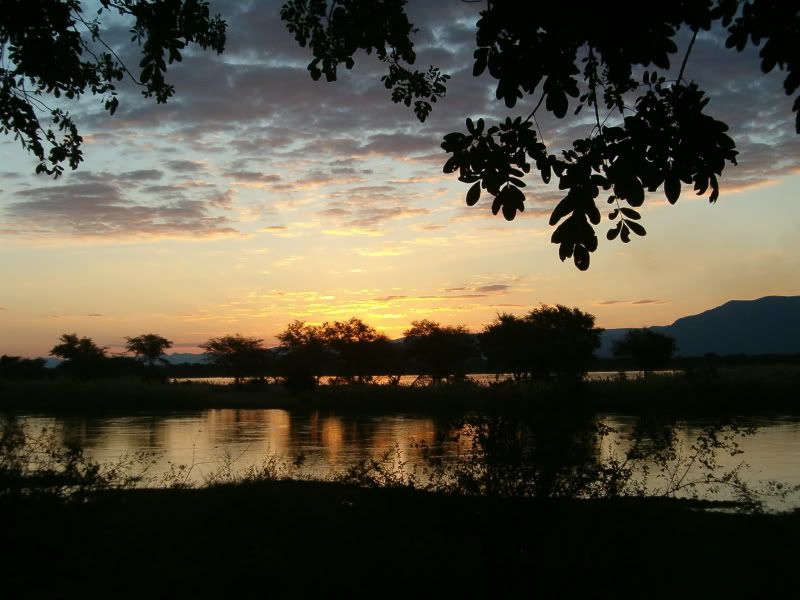 My first Zambezi sunset 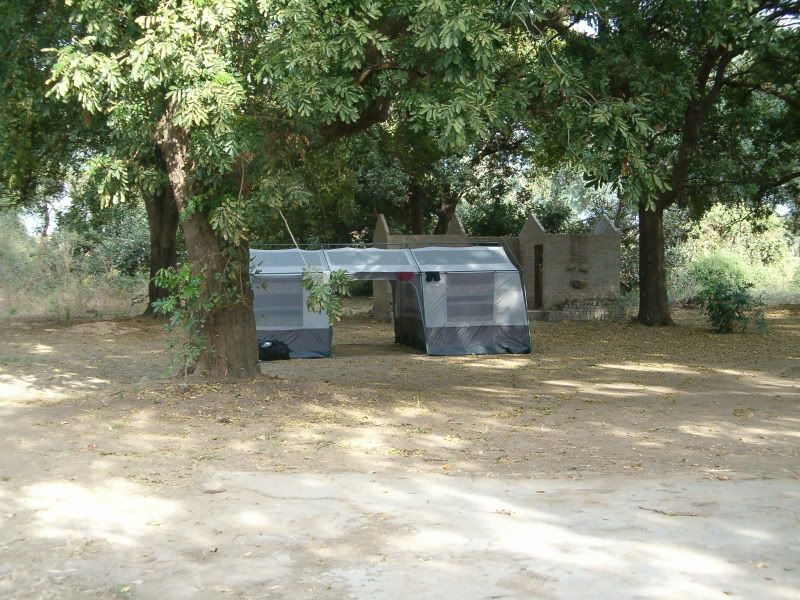 My home in Zimbabwe 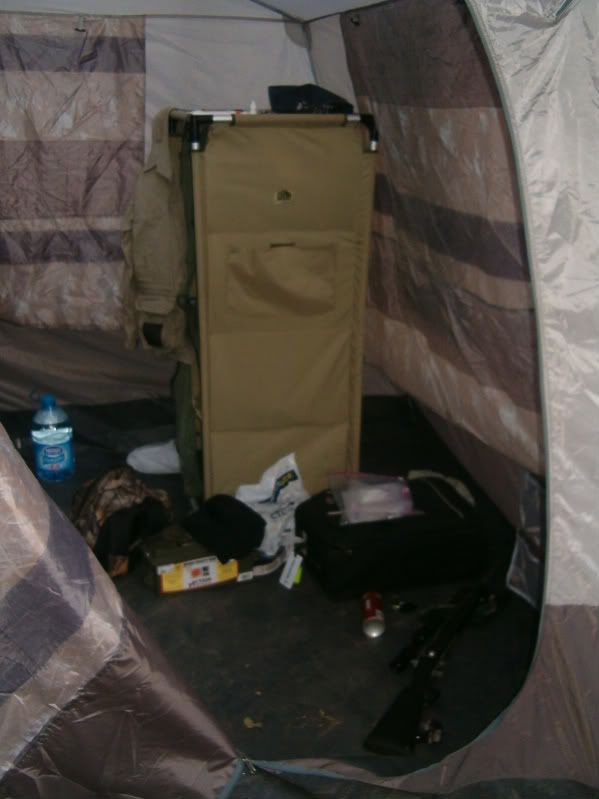 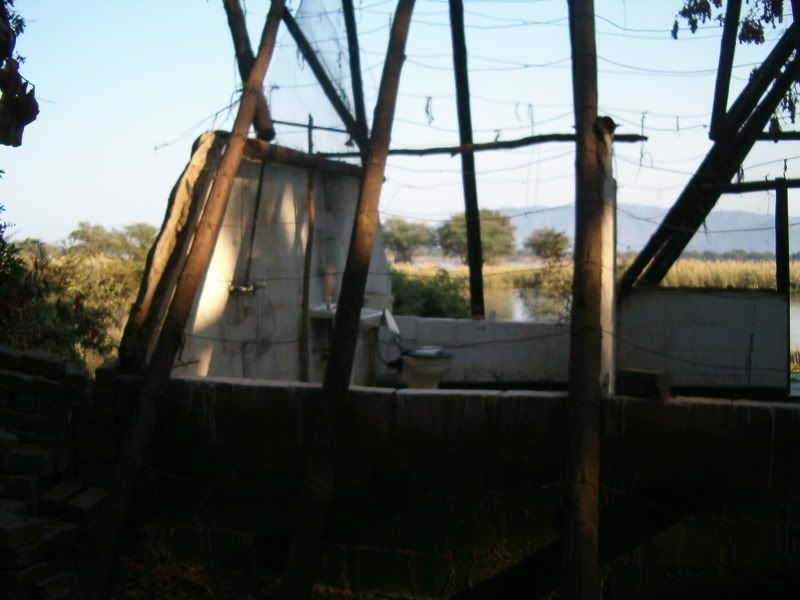 Zim bathroom, well air conditioned.  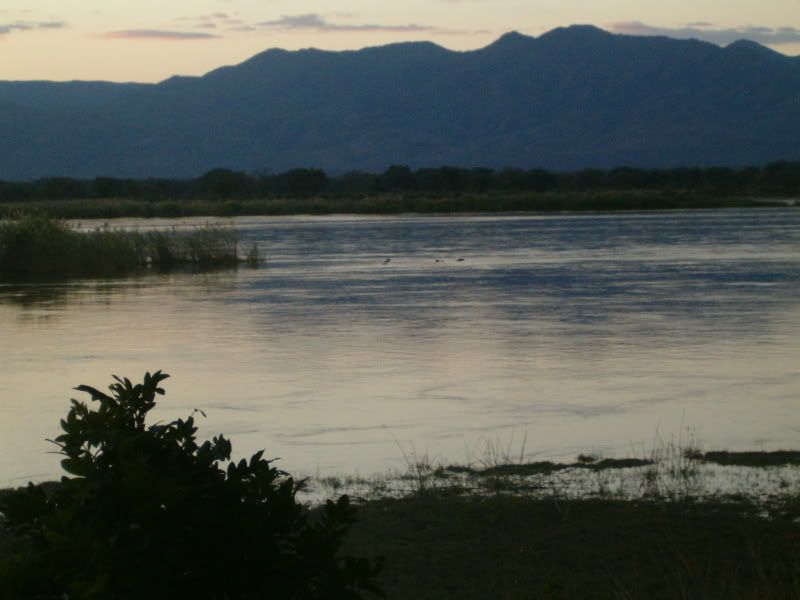 The camp hippos The following morning marked the beginning of my Zimbabwean hunting. We checked the zero of both my rifles, and they were still on. Off we went in search of buffalo. On the dirt roads of Nyakasanga we saw lots of elephant sign, and then later a tuskless cow. This turned out to be the first of our daily elephant sightings. I never know something so big could disappear so easily. A few minutes later we saw some lions; it looked like they were coming out of Mana Pools following some prey or other. Eventually we found buffalo dung and tracks fresh enough to follow. We followed the tracks for about two hours and finally caught up with them bedded down. I had now seen three of the big five within a matter of hours. The buff must have caught wind of us while we were maneuvering around to get a better look. I got a brief look at a good bull while he was lying down, but never had a chance at a shot. We let them move on before taking up the track again. We made brief contact two or three more times but never got a chance at a shot. Our final contact with buff that day was unintentional. We were following the tracks of our herd when we bumped a second herd off to our left. We ended up taking their tracks as they seemed to have a better selection of mature bulls. Their tracks eventually splintered into three groups, so we called it a morning after 5 hours of walking and headed back to camp. I say we called it a morning, but it was early afternoon. 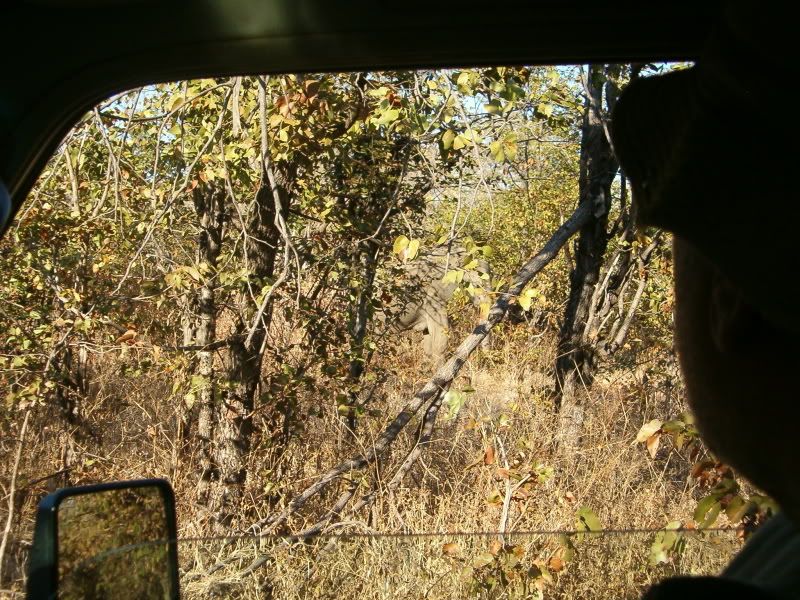 Tuskless cow We had a lunch of breakfast type foods (eggs, sausages, etc), and while Stephen napped I took pictures of the camp, and then settled into my tent for a nap as well. Before the nap I did see a vervet monkey sneaking into the trash pit. It was rather comical to see him coming out of the pit and look around furtively like he knew he was doing something wrong and was worried about getting caught. The afternoon was spent driving again looking for spoor to follow, but none could be found. We saw plenty of other game such as impala, waterbuck, and zebra. The zebra here seem to know that they are protected, they will just turn broadside and look at you and take their time moving away. The impala on the other hand are gone about as soon as you see them. The only excitement of the afternoon was seeing a hippo cross a clearing. After a brief discussion about fees, we took off after him. We followed him into some tall riverside jess, but he made it into the river before we caught up with him. Even without encountering him it was one of the more adrenaline filled moments of the hunt. It was definitely a rush just knowing that we could run into the hippo at close range at any moment. After that it was back to the truck and then on to camp for the night. 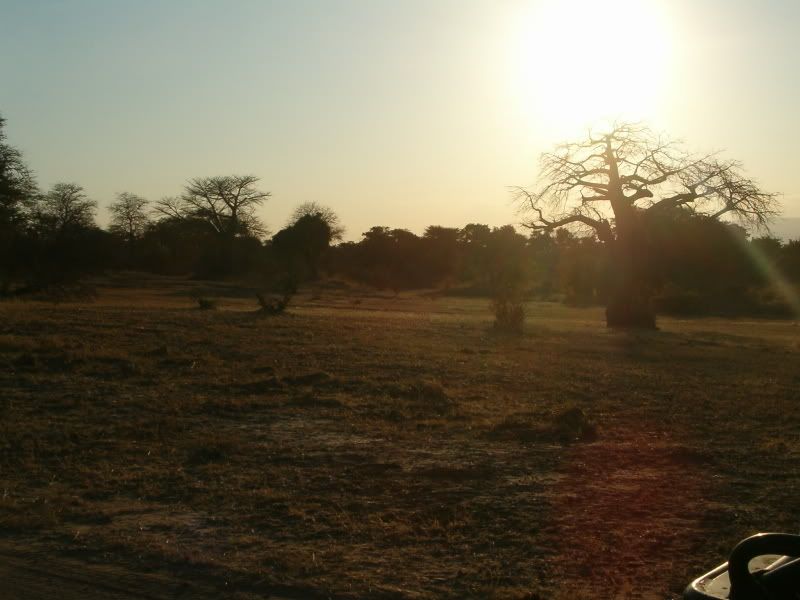  Area where we pursued single hippo. We left camp early the following morning at about 6 A.M. Again we started driving around looking for tracks. It was taking a very long time to find any fresh enough to follow. Stephen was a little worried because with his last client they had taken a bull on the first day, and then spent another ten days to get a cow. In between they had a very hard time finding any buffalo at all. Eventually we found fresh dung at about 10 A.M. The previous day we hadn’t brought water on the truck, and I’d wished we had. We rectified that situation this day, and I made sure to hydrate well before we set off. Within the first 50 yds I had a branch hit me below the eye. Somehow I took this as a good omen. The tracks were easy to follow through most of the jess, and as we seemed to be closing in Stephen, Joshua and I left Tackie and Chiggie behind. Suddenly we heard a lot of movement, Joshua said that the buffalo had smelled the others and were moving off. We quickly moved parallel to them and found ourselves in a dry riverbed. About 100 yds ahead a black shape was crossing. Even at this distance I could tell this was the buffalo bull of my dreams. I had previously told Stephen that what I wanted in a buffalo in order of importance was a hard boss, next was good drop, and that as long as it was something beyond the ears spread didn’t really matter. This bull had it all, especially the bosses. They were tall and obviously hardened and fused. (As I look back on that image of him burned into my memory I think he may have posed for South Africa’s 100 Rand note.) Unfortunately we got into the river too late to get a shot at him. We set up the sticks ready to lay in wait for the rest of the herd. Within a matter of moments Joshua announced what I’d already figured out; that bull was the rear guard, not the leader. We picked up the sticks and started moving again. Joshua seemed to know where they were headed without actually following their tracks. These took us through some thick jess, and then to an area of taller trees that was relatively clear. We could see the herd coming into the clear, but they were further away than we had hoped. Stephen ranged them with his binoculars at 150 yds on the closer side of the herd. He picked out a good bull and gave me some landmarks to make sure we were looking at the same one, he through his binoculars, and me through the Leupold on top of my 404. I had told him about a previous safari where the PH and I weren’t on the same page regarding an eland, fortunately for both of us the eland I took turned out to be an even better one than the one the PH intended me to shoot. “150 yds, aim six inches high, take him when you canâ€. As I timed my wobble I jerked the trigger and nothing happened. I hadn’t completely disengaged the safety. I am a big believer in providence, and the old saying that “thing always happen for a reasonâ€. In retrospect I’m glad that the safety was off because I could feel myself jerking on the trigger instead of getting a good controlled squeeze. If the safety had been off, we’d soon be trailing a poorly hit ton of black bovine fury with payback on his mind While I received a short but stern lecture about needing to “always be ready†(never mind my concerns about gun safety), a cow and young bull seemed to notice us. They watched us for a bit but never spooked, and soon returned to feeding. Stephen picked out a bull near the end of the herd and directed me to him. We could see a good boss from the side and could tell he had a nice drop, but never really saw his horns from the front. We knew it wasn’t the bull from the river With the safety completely off, and somehow more relaxed this time I settled in for the shot. “Okay that’s about six inches up from where I want it to be, deep breath half out, that little bit of wobble should put it right where I want it and the end of squeezing should come together right about …..NOW.†This time there was a loud noise and lots of black shapes moving in the clearing. The herd bunched together and moved a little bit before moving off. Joshua and Stephen agreed that it looked like a good hit. Joshua said he saw him jump and “bunny hopâ€. We were moving to where he’d been standing to pick up the blood trail when we heard it, that awful mournful sound that is music to a buffalo hunter’s ear: the death bellow. It was coming from a patch of jess on the other side of the clearing. We moved quickly to the edge of it trying to see where the buff was and make sure the bellow was an accurate depiction of his condition. Chiggie and Tackie had caught up with us, and Chiggie spotted him, on his feet facing away from us. Stephen looked around a bit, and then saw him on the ground facing us. He fired an insurance shot, and we then swept around the jess to make an approach from the rear. The buff was on the ground flailing, trying to get up but thankfully not able to. I fired a solid into his chest and within a minute he stopped all movement. We walked up to him carefully and he truly was done. The first thing I notice was the entry hole of my first shot; pretty much exactly where Dr. Robertson says it should be. I then look at his headgear as I come from his side to his front; nice spread, decent drop, and the bosses. Suddenly I feel my heart drop and I remember Ruark’s disappointment with his kudu. This bull still had quite a way to go in terms of hardening his bosses. I can feel satisfied with the stalk, the excitement of the hunt, satisfaction with the shot placement, and I have to remind myself that those are the real trophies. I wasn’t concerned about spread or record books; I wanted an older bull with good hard bosses. It just means I’ll have to keep hunting buffalo, as if I wasn’t hooked already. I looked down at my watch and was amazed to discover that this whole process had taken sixty six minutes. It took longer than that for the pictures, skinning and quartering. I was able to feel some elation arriving back in camp that afternoon and evening back in camp, I’d now taken a buffalo. We spent the afternoon searching for impala, and even got out of the truck a couple of times, but we never were able to take a shot. They were often off too quick, or a suitable ram wasn’t spotted in the herd. That night I saw another hippo head in the coals. Stephen saw it this time as well. 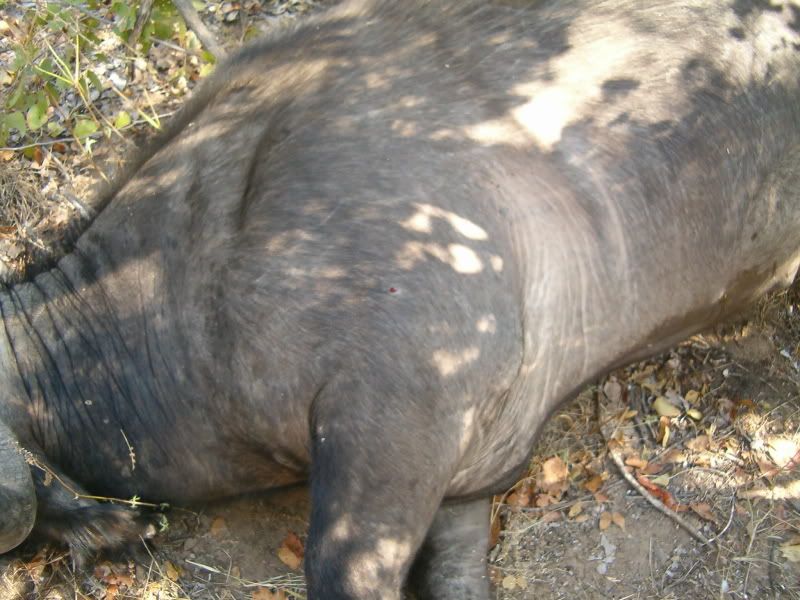 First shot 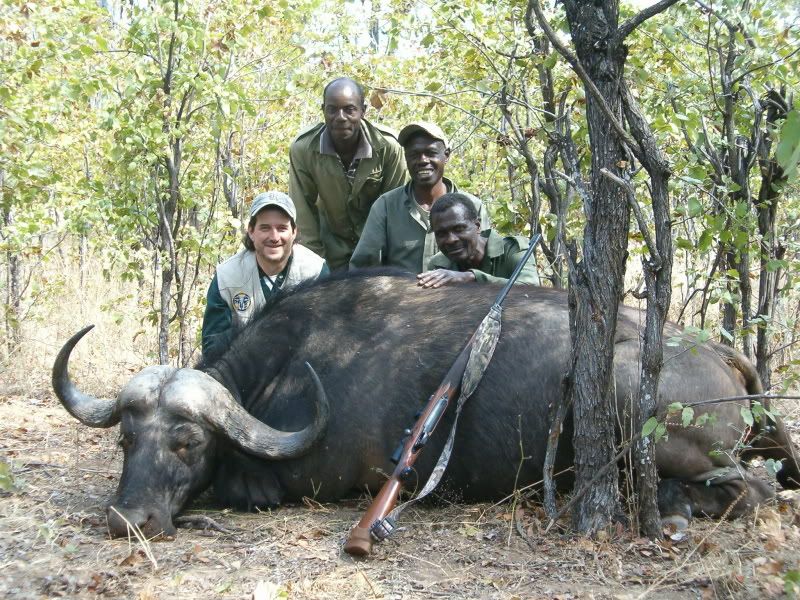 Me with Chiggie, Joshua, and Tackie Me with Chiggie, Joshua, and Tackie 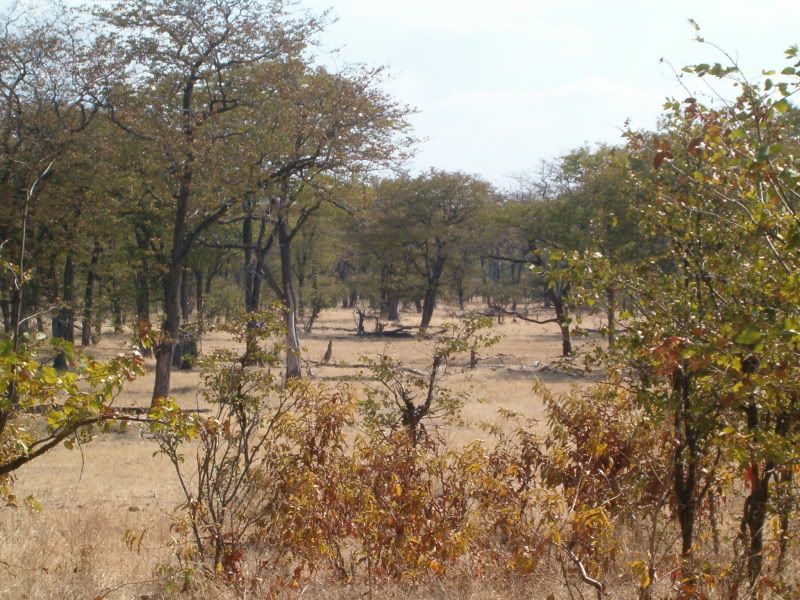 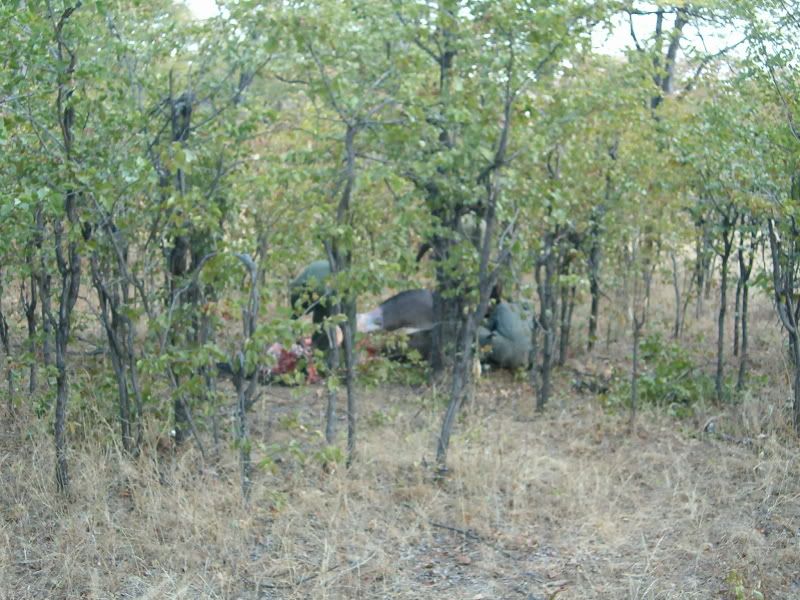 From the edge of the jess looking back at where shot was taken from. 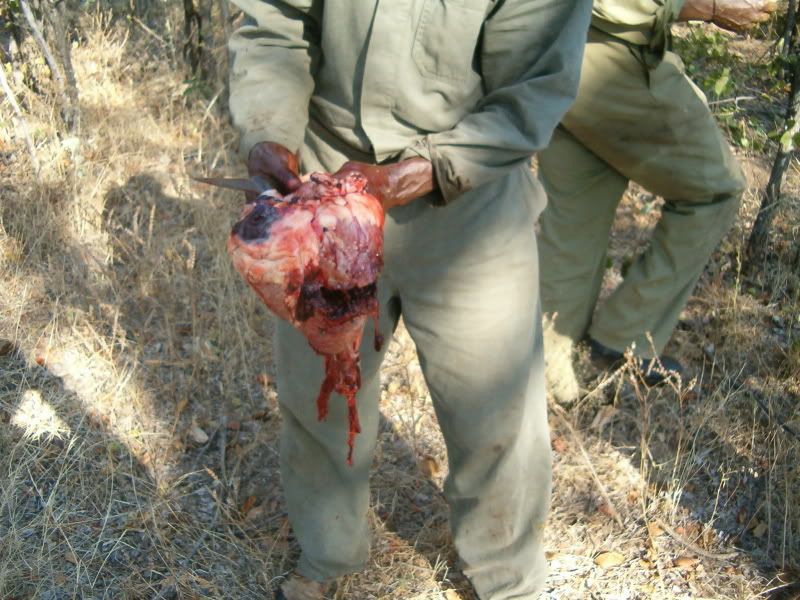 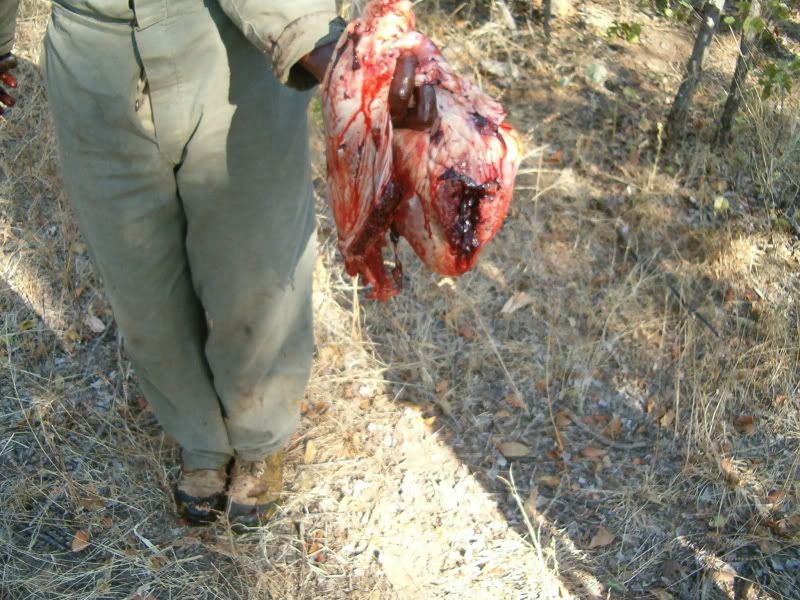 What 400 grains Swift A-Frame does to a buffalo heart. I also have a whole new respect for hippo hunting. I've seen it done on TV where they shoot a hippo in the water. I had my doubts about this method. I will admit that it is a test of marksmanship, but I wasn’t all that impressed with the stalking involved. We were a bit limited in shots to take. We didn’t have a boat, and with the way the Zambezi was flowing we didn’t want to take one in the river. This meant extremely small, shallow pans that would hold one bull at most, or catching them on land. We checked some pans where we might find one, and we finally did. He knew we were there too, and I have a feeling that this wasn't his first encounter with hunters. He'd only show us his nostrils. After moving to various spots around the pond, he'd move around too, bringing up only his nostrils at about 2 minute intervals. This fellow has given me a whole new respect for the stalking of hippos in water. Eventually we gave up on him and moved on to try some other locations. We checked a marshy almost dry river where Stephen had seen hippos before, but none were there. There were a couple of crocs on the other side, one of which was an absolute monster, but no croc on license. There was one last place to try, the junction of the Mongwe River and the Zambezi. We finally found a pod sleeping on the banks of the confluence. Our original location offered a 150 yd shot which I didn't really feel up to. My buffalo heart shot had been perfect, but a hippo brain is quite smaller. Additionally if the shot wasn't perfect the hippo could make it into the Zambezi and even if he died he could be 50 miles downstream when he floated to the surface. We then backed up until we found a suitable path to stalk up to them after crossing the dried Mongwe River. We finally found some taller grass about 85 yds away. We watched them for a while trying to figure out which one was a bull, finally Stephen said "The one facing away with 2 birds on his back". I settled in for the shot, waited until he was broadside, took aim midway between eye and ear and fired. The hippo fell and pandemonium erupted. Suddenly my hippo was back on his feet headed for the Zambezi. Stephen fired 2 more shots, and the hippo was turning around, pink mist erupting from his nostrils. Now he was headed in our direction. It's funny how things slow down and how all the different thoughts come "There goes a $3,000 trophy fee", "WOW! Look at that pink geyser, he’s definitely been hit.†"Okay now he's coming towards us I can take another brain shot", "Ummm, if he’s coming back towards us, that means we’re being charged†“We’re being charged by the animal that kills the most people in Africa", "Okay at that angle just inside the left eye should do it", "Man what a flop and roll after that shot". All of this took maybe 10 seconds a most. The hippo was finally down, and Stephen put one in through the top of his head as insurance. As we came closer we could see that my shot was about 2.5 inches low. I guess him falling at first was my 375’s Taylor KO value of 40 in action. My second shot was right where I intended it to be, just inside his left eye. The vultures were circling even before the pictures were finished. The crew suggested we needed more manpower to skin and quarter the hippo. We headed to the Mongwe ranger station to get more help, and they were more than willing to help for a share of the nyama. They were more than willing to help for a share of the meat. It was quite an experience to watch them work, and in a protein starved, or rather just plain starving country they crew was almost singing as they worked. Still glowing from the hunt I was really feeling on top of the world when Stepehen said "Caleb you have made a lot of people very happy in the past 2 days." 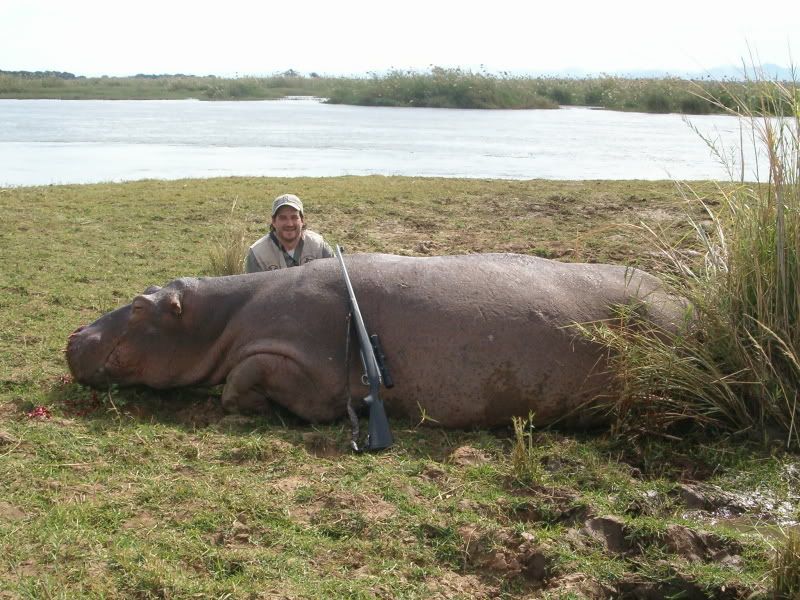 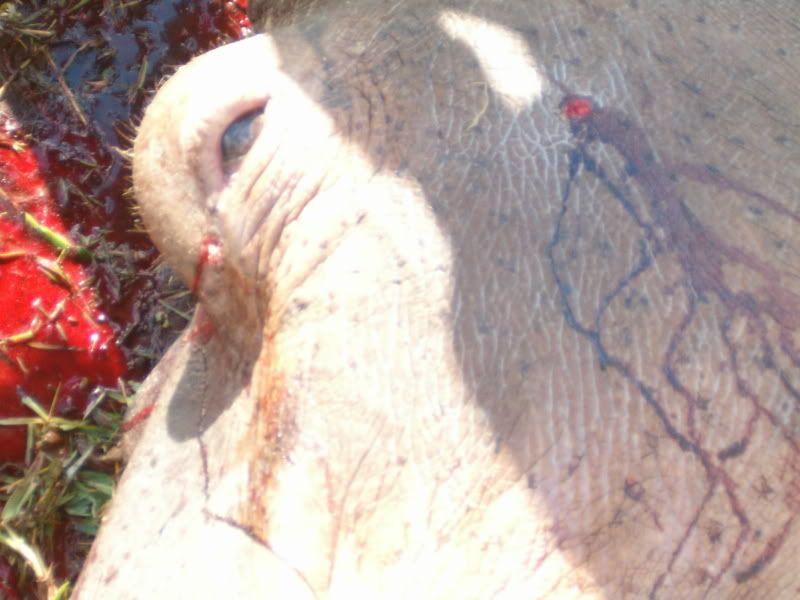 My 1st and 2nd shots. My 1st and 2nd shots. 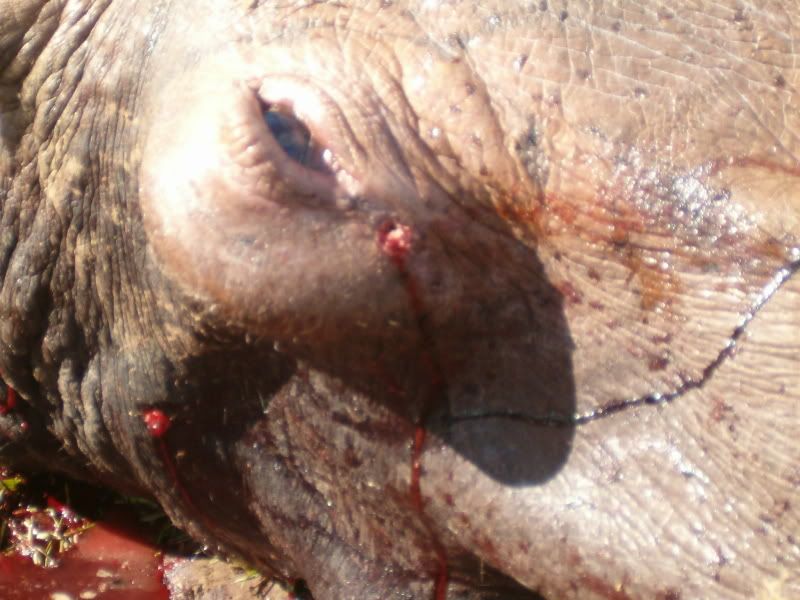 My 2nd shot and the insurance. 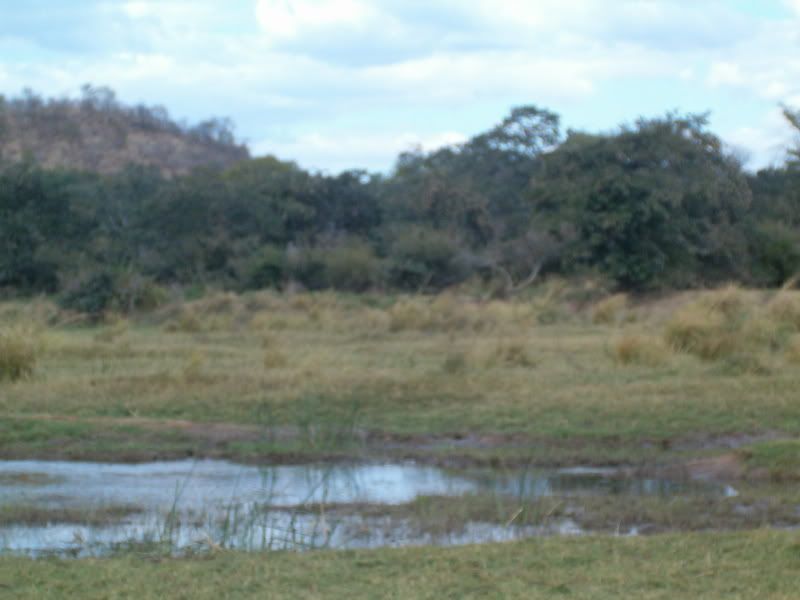 1st shot was taken from clump of grass in front of dead tree. 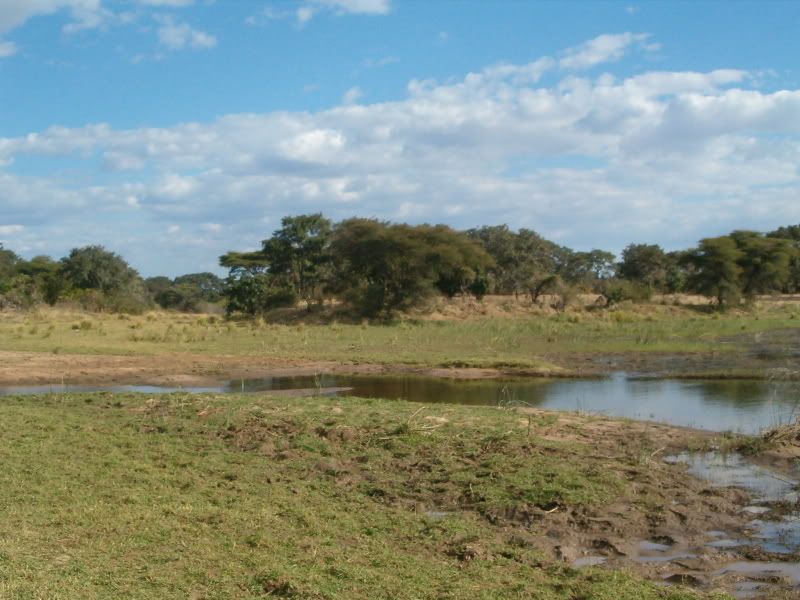 First spotted hippo pod from the trees in center of picture. After loading up the skin and meat I witnessed one of those spectacles seen only in Africa, the vultures closing in on a carcass. They started coming right as we left, and within 2 minutes some were leaving because there was no more room at the table. We dropped off the rangers and their meat at Mongwe and headed back to E camp. Sleep came easily that night. The next day we’d look for impala and hyena in the evening. At this point anything else in Zim was a bonus. I already had the animal I wanted, and another one as a bonus. Caleb | ||
|
| One of Us |
I enjoyed reading that! Looking forward to more. Proud DRSS member | |||
|
| One of Us |
Zimbabwe and South Africa 2008 Part II Day three in Zimbabwe started early again with coffee and rusks. The trackers said we needed to go back to their village to get wire for the hyena baits we’d be putting out later that day. Stephen said he expected something like that; a convenient excuse for going to Marangora to deliver the meat. We delivered the meat, and also dropped off the buff and hippo skulls for boiling. The people seemed excited about the nyama. We returned by a different route, hoping to catch an impala along the way. Chiggie had mentioned needing one for rations, as had the scouts from D camp. Multiple times we saw some, but never had a successful stalk on a herd with a good ram. Between rations and baits they are probably one of the most if not the most pressured species in the area. Somewhere along the way Joshua spotted a grysbok. Another animal I hadn’t planned on taking, but when I saw we had one on license I’d said I’d take it if we saw one. The truck stopped and we started trailing it. I never saw it, neither did Stephen. Chiggie said he saw it running to the other side of the road so we gave up. I wasn’t really bothered by this; I already had what I was after and a big bonus already. We continued on the road to camp and had a couple more fruitless impala stalks before reaching camp. The roads here seem to be made out of elephant dung. We did see a herd of elephants along the way, but this was actually our first herd to see. We’d only seen lone ones before, including a bull in musth. It was kind of funny about that bull, he was hanging out by some trees where we’d seen a baboon troop on all the previous days. After the bull was there trumpeting away, we never saw the baboons at that location again. Finally we made it back to camp. Some lunch and a nap and it was time to bait for hyena. We took the bones of the hippo and buffalo out to the boneyard, and while the crew hooked it up with wire, we cleared out an area under a nearby tree for our blind. We didn’t really make a blind, just used what was already there and made a place to sit. Stephen expressed reservations about the location. He said that the hyenas would have been hunted hard in this area and he had doubts about them coming during daylight hours, but he would defer to local knowledge. He also pointed out that the vultures were circling, and likely to take all the bait before the hyena had a chance. The boys covered the bait once they had it set, and then we noticed that the birds had disappeared. We had some time to kill before dusk so it was off on the trail of impalas again. We soon found out why the vultures had disappeared, another hunter had taken a hippo on the bank of the Zambezi. The birds were perched and waiting much like I had seen them do the previous day. Someone involved in the hippo recovery waved and we headed over thinking they needed some assistance, but they were just being friendly. We had a brief talk with the PH, and he said something about hippo hunts being underrated. After mine I had to agree. Baiting for Hyena 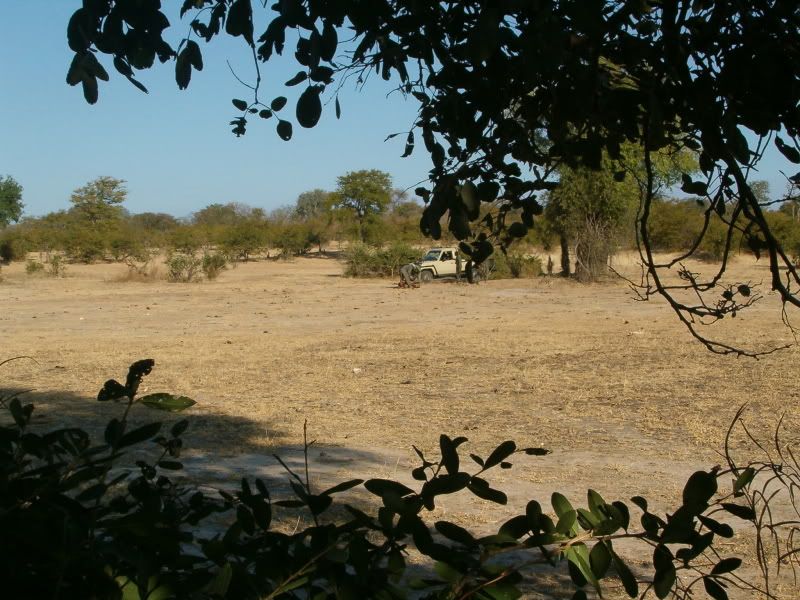 The hyena hunt was pretty uneventful. We just sat under the tree until it was too dark to see. No sighting of hyena. After dinner we went back out to look, and sure enough there was one there. We now knew that a hyena had hit the bait, the question would be if they were still there in the morning. We woke up extra early and walked to the hide. When we reached the site my rifle fell off my shoulder. The sling stud had come out of the stock, and the gun came off hitting the ground barrel first. A quick check showed no obstruction of the barrel, so we took up our positions and waited. We couldn’t hear any bone crunching and as it grew light we couldn’t see any movement. The hyena had been there only during the dark when no hunting was allowed. Just as Stephen had predicted, these hyenas had been educated. He said that with the previous client they’d had hyenas almost climbing into the blind with them when they’d been hunting leopard in another part of the safari area. Over breakfast we started discussing plans for the remainder of the hunt. Bushbuck was my priority, and I let him know that. A series of events was telling us that a return to South Africa was in our best interest. Stephen had miscalculated the amount of red wine to bring, so we were now out. The camp no longer had running water, my 375’s sling had broken, and sometime the previous night I started having a problem with my contact lenses. Add up these omens and it’s like we were getting a message to get away. Couple this with the fact that we were seeing less game every day, and it all became very clear. Camp was packed up and we were headed south. As a side note I’m glad we took the buffalo when we did. During our driving while looking for hippo and impala the previous two days we hadn’t seen any fresh buffalo sign. I don’t know if they moved into a different part of the safari area, or if they went into Mana Pools. I will admit we weren’t looking quite as hard for the buffalo sign, but we were keeping an eye out for it all the same. One last Zambezi Sunset 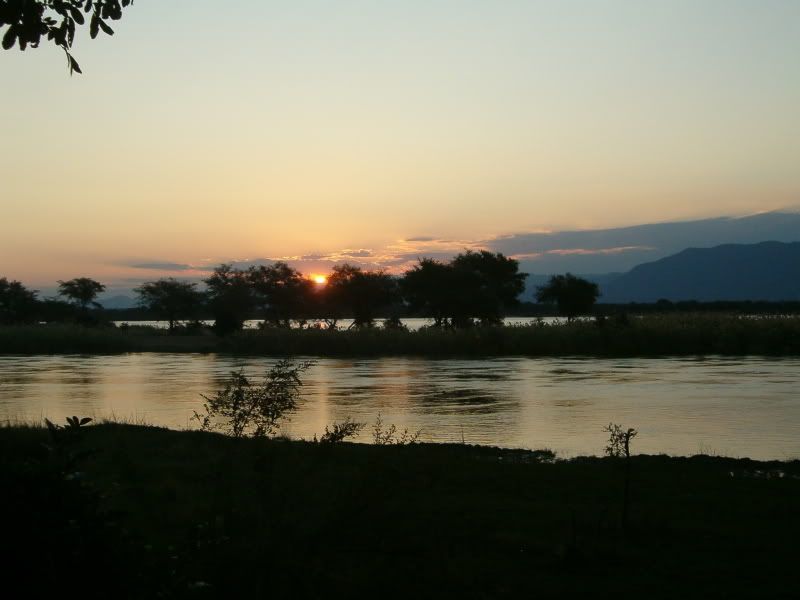 The drive back to South Africa was basically a reverse of our drive to camp. We dropped off the crew and checked out at the ranger station, and then off on the highway. We did have fewer roadblocks, mainly right around Harare. A side trip was made to Bromley to the taxidermist, and between Harare and Bromley we were pulled off to the side at roadblocks. It seems the skulls and skins caught their attention. At the second one an officer walked over and said “We need to find out about the meat.†Somehow I have the feeling that they would have taken it if there was any. After dropping off the skulls and skins, and passing through those same roadblocks, we hit the outskirts of Harare at rush hour. The only problem we had the rest of the way in Zim was running over a roadkill donkey outside Bubi River. We reached the border a couple of hours after dark, and went through the border crossing procedures without any hassles at all on the Zim side. Things were even quieter on the South African side. The person in charge of sound effects for this adventure even had the cricket chirping turned on. A quick stop at a fuel station and we were headed for Alldays and Stephen’s lodge. At the fuel station I got a Coke, and realized that this was a Coke from my childhood. I’d forgotten that in America ours are made with high fructose corn syrup, this one had sugar. It was wonderful. Even more wonderful were the hot shower and a real bed at Xomaqua. We made it in about midnight, and had a wonderful dinner largely prepared by Joanne, Stephen’s future daughter-in-law. I called my wife and let her know how good the hunting had been, and how much I missed her. I also told her to be glad she hadn’t come along (nevermind that Stephen assured me that we’d have never gone to Nyakasanga with the girls along). I was tired and sweaty, and the shower really got me relaxed. Sleep came easily again, and somehow I was the first person awake the next morning. I went out to the sofas on the main lodge’s patio and started writing in my journal to catch up. Soon after that came the “light breakfastâ€, and the others started waking up. At Xomaqua, Stephen’s son Devlin would act as my PH. We went to the range to recheck the sights on my 375, and they were off quite a bit from previous; maybe the bouncing around in Zim, or that slip when the sling swivel gave way had disturbed it. I finally got it resighted, or at least close enough without running too low on ammo, and we were off for impala and/or blue wildebeest. I’d budgeted to take a wildebeest, looking for a rug for Mom. In 2005 I’d bought her a springbok skin which has become quite a conversation piece for her, but I wanted her to have a skin I’d actually shot myself. When I told Devlin what my requirements for a wildebeest were, he was quite delighted and told me that I must be the easiest client to please he’d ever had. It did make for an easy request that I didn’t care what the horns looked like, or even if there were horns at all, just a good brindled skin. My chalet 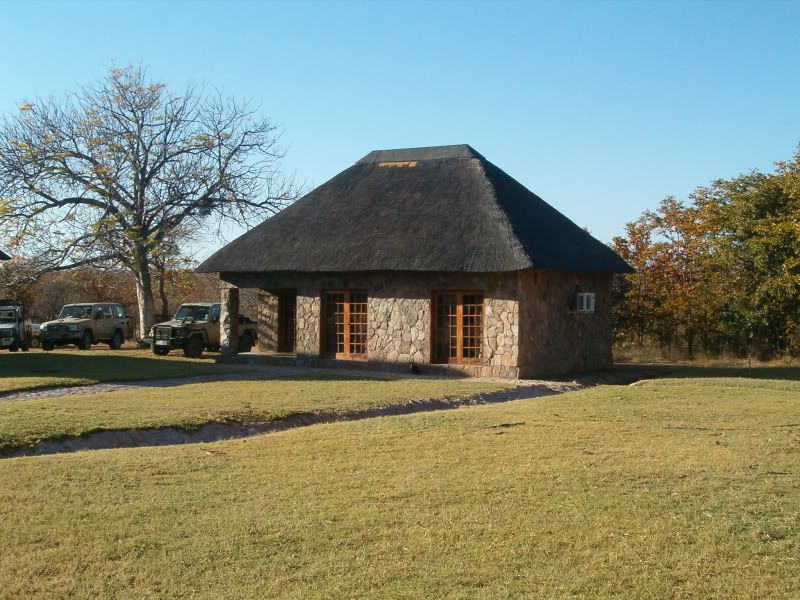 The main lodge 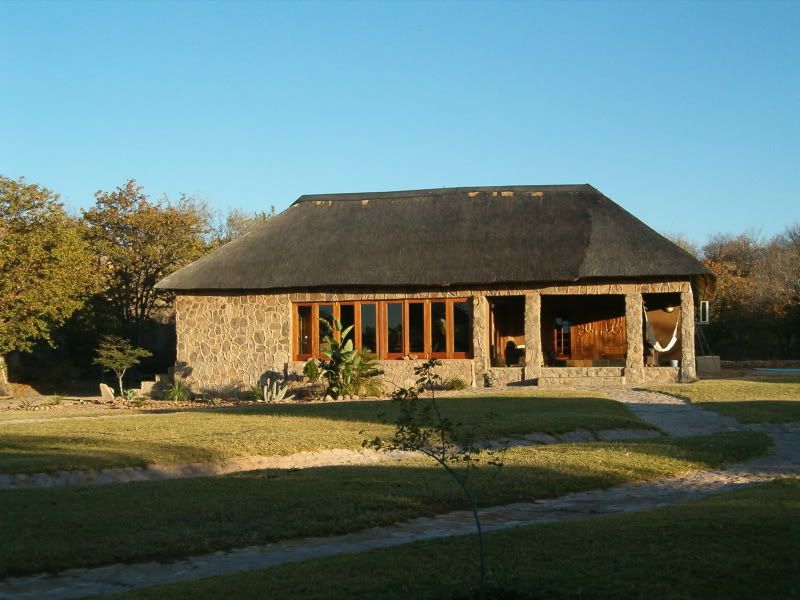 Facilities in the chalet 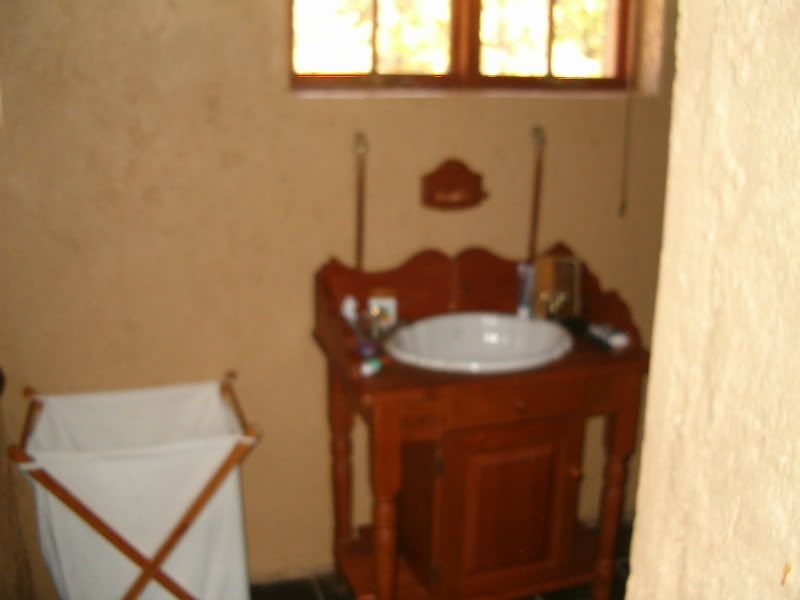 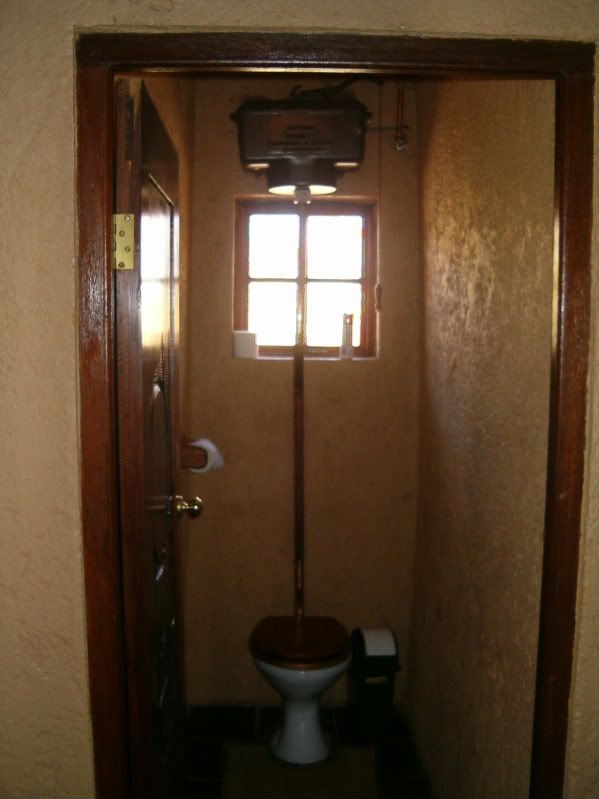 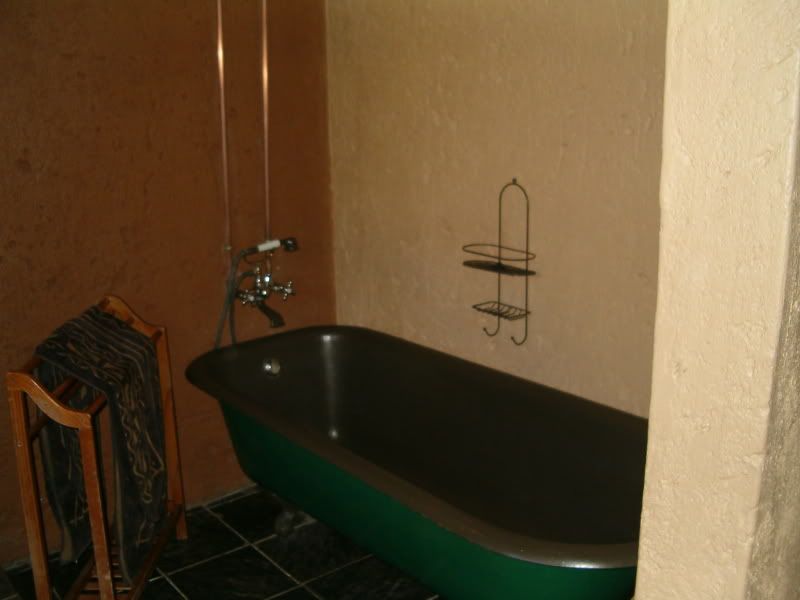 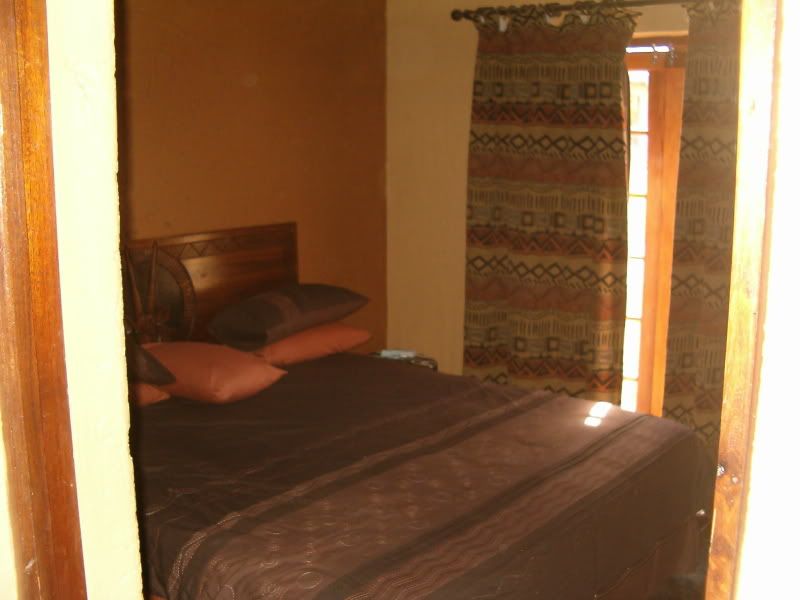 We drove by some areas where impala were known to haunt, but never saw any. No wildebeest either. We drove until we reached a dry riverbed, at which point we got out and started stalking on foot. As we rounded a corner we came across quite a variety of game: a single tusked warthog, some impala ewes, baboons, a female waterbuck, and some kudu bulls. We watched them for a while and as they moved away we made our way through the riverbed to a dried pan. Along the way more warthogs, waterbuck cows, one decent waterbuck bull, and then a giant of a kudu; estimated at about 55 inches on his longer horn. Unfortunately the other horn was broken about 5 inches shorter. This fellow just walked and fed by us at less than 60 yards. When the kudu cleared we slowly went up the bank of the dried pan. When we reached the top we saw a group of kudu cows. Unfortunately they were in our path so we had to wait them out. While we waited, a waterbuck crossed the pan and took a rest under some trees on the far side. Devlin was very excited about this one. We’d had a discussion at the kudu sighting that although I hadn’t planned on a kudu or waterbuck, if I came across the “trophy of a lifetime†I’d take it and worry about payment later. Within that context Devlin said “I’d take that waterbuck.†Now we just had to wait for him to stand. To further complicate matters, I wasn’t in a good position and we had kudu cows just off to our right who could spook with any motion. Devlin figured out that I could put the rifle on his shoulder and the sticks in front of him for me to use as a rest. I set up and it was reasonably stable. I thought the shot was at my outer limits of comfort, but not out of them, so I readied myself and waited for the waterbuck to stand. After what seemed an eternity the kudu cows noticed us and started running away. The waterbuck stood and almost seemed to pose for a broadside shot going to my right. I got the crosshairs on him quickly and fired. I felt good as I squeezed the trigger and felt no pulling of the shot. He dropped instantly, which was a pleasant surprise. We leisurely walked up to him, and as we approached, he didn’t move at all. When we reached him I could see why, it was a perfect base of the neck shot. Unfortunately I had placed the crosshairs for a heart-lung shot. As for horn quality I was quite satisfied. We looked back at our perch beneath the trees, and Devlin estimated that it was a 250 yard shot, a bit longer than the 225 I’d originally estimated. I now thought it was more in the 275 range. When we brought the truck in to collect him we used a rangefinder and found it to be 260 meters, which made it 283 yards. That is the longest shot I have ever taken, much less made. My sights were also off to the right just a bit at 100 yds earlier in the day, which would obviously be magnified at this distance. Whatever the cause, I now had a waterbuck. It was making me a little nervous though. Waterbuck where he fell. Shooting point in background 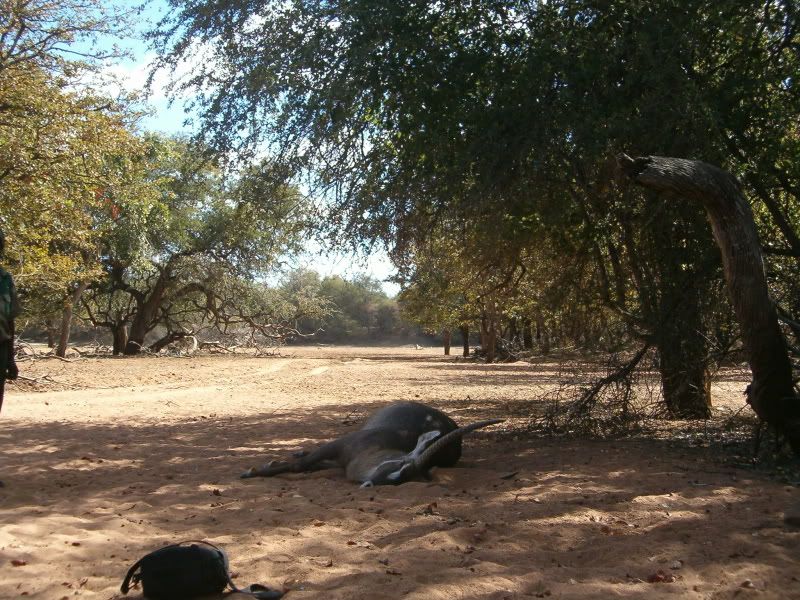 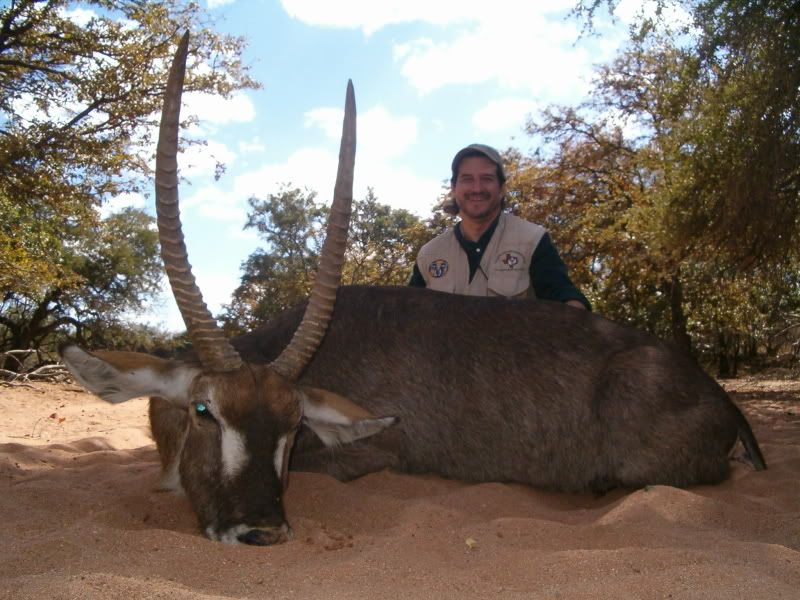 The afternoon was spent hunting on foot with impala, wildebeest, and/or bushbuck as the quarry. We went to a different area of the property where there were open plains leading into some riverine bush. There was another pan which was largely dried up, with just a very small amount of water remaining. While crossing it we were caught in the open by a small herd of impala. This herd was mainly ewes with a few young males. We sat still and let them drink. A couple of them spotted us, but since we didn’t move they just drank and eventually they moved on. Devlin mentioned something about Joanne making arrangements to hunt bushbuck on a different property that evening, and I didn’t think too much of it at the time. We continued to stalk the area and eventually we were back at the truck. We drove back to the lodge and reached it right as the last light was fading. Over dinner there was discussion of the bushbuck hunt, and it was then that I realized they were talking about the hunt being that night. I wasn’t really prepared for this. I think my eyes must have looked as big as the desert plates when I realized what they were talking about. I asked if that was a common practice in this area; thinking along the lines of “When in Rome…†He stated that it wasn’t the only way bushbucks were hunted in the region, but was fairly common due to their nocturnal nature. He also said bushbuck was frequently hunted with shotguns on driven hunts in Natal. To complicate matters, there was also a question of exactly what constituted privately owned lands and what was government owned along the banks of the Limpopo which held the absolute best land in the area. Devlin was all for it, and seemed a little surprised that I wasn’t just jumping at the chance to go. Joanne seemed to understand a bit better, but still she seemed to be thinking that she’d spent the better part of an afternoon making arrangements for nothing. Stephen was a bit more philosophical; his recommendation was to at least go out, and see what it was like. If I felt it was too unsporting I could just call it off and other arrangements would then be made. He did add that the spotlight hunting they had made arrangements for would be on a farm for a crop raider, and that if not shot would likely just be poisoned. After dinner we took off on what ended up being almost a 2 hr drive in the dark. Most of the drive was along a fence line separating Botswana from South Africa. A few wrong turns were made, and at one point we even questioned it we had accidentally crossed into Botswana. Along the way I started hoping we’d get frustrated and just turn back. I also started having hopes that no bushbuck would be spotted, and even gave some thought to missing a shot on purpose. Just had to keep telling myself “When in Rome…†Finally we reached the farm, I can’t remember his name but the landowner was of Afrikaner descent, and he seemed glad to have someone there to take a bushbuck. He joined us in the truck with some of his dogs. We drove to one of his potato fields, and there seemed to be a shape moving off in the distance. The truck was stopped, and the spotlight turned on. There off in the distance was a bushbuck. It seemed to have decent horns, and soon some decisions had to be made. The first one was fairly easy for me because I would be deferring to Devlin: were the horns big enough? The second one took a little bit of thinking; did I want to take him like this? As I watched him walking around enjoying this giant smorgasbord of potatoes (or was it tomatoes?) while being spotlighted continuously, it suddenly hit me. He was paying no attention to the light at all. I had never spotlight hunted before, but had always heard that deer or other animals would freeze when hit with a bright light in their eyes. I’d seen the effect of headlights on whitetail deer many times and just assumed most animals would react similarly. This guy didn’t seem to care at all. I don’t know if this is the norm for bushbuck because this was the first one I’d seen, and he was alone in the field. Maybe this is the way they usually respond, maybe this one had a brain tumor, or was just too excited about the feast that this field represented. Maybe he was just stupid. I don’t know, and will probably never know. I agreed that if he walked into an area where I had a shot I’d take him, but we weren’t going to use the truck to move him for a better position. With the truck parked I’d use it much like a treestand or elevated blind. Eventually he walked into an area which provided a clear shot. I steadied myself and settled in for a chest shot at what I thought would be a 100 yd shot. I squeezed a shot I felt good about, and then all I could see was smoke. Devlin shone the light in the area where the bushbuck had been, but he was nowhere to be seen. The farmer took his dogs out off in the direction of where he had last been seen, while Devlin continued to sweep the area looking for a wounded bushbuck. Now he shone the light towards the farmer, and we could see that the dogs had settled in an area and were almost fighting with each other. The owner reached them and although I couldn’t understand his Afrikaans, he sounded happy. Devlin went out to where he was and they started making their way back trying to keep the dogs off of their load, a bushbuck. He’d fallen at the shot; once again the shot hit him right where the neck joins the shoulder; high and right. The next day would definitely start with a trip to the range. As we dropped the landowner back at his farmhouse he told us that we were welcome to come back any time for porcupine and warthog at no fee. Bushbuck 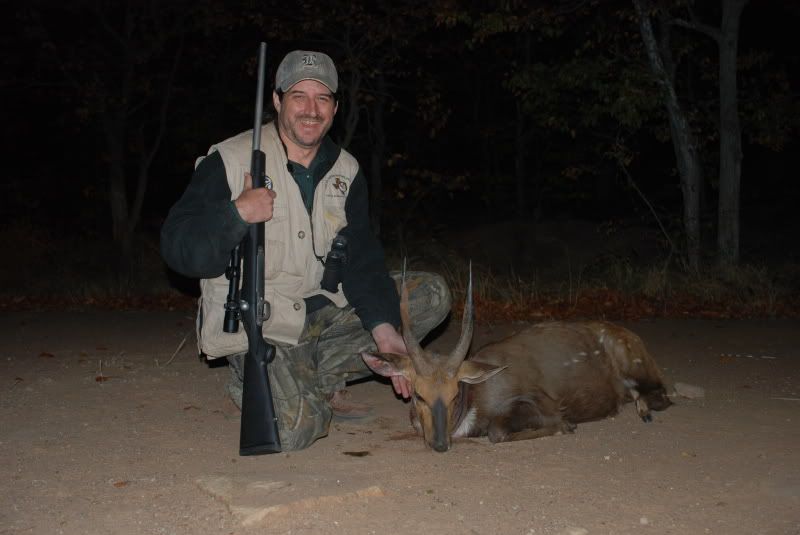 As we drove back, and even as I write this, mixed emotions color this episode. On the negative side it was at night with a spotlight from a vehicle, which goes against tradition and the laws of hunting where I live. On the other hand the bushbuck had plenty of opportunity to leave, he wasn’t chased with the truck, and the light didn’t paralyze him the way it seems affect much of North American game. If anything the light should have scared him off. It also was not against any South African hunting laws. I’ll hunt bushbuck in the future, but I doubt I’ll do it this way again. I do realize that it is mainly the dogma of hunting ethics that trouble me about it; as an experience it was not that much different than sitting in a stand hunting whitetails over a crop field. I won’t really argue either way about how “sporting†this was; arguments can be made either way as I have been doing in my own mind ever since. I will say that part of why I am interested in hunting the entire Spiral 9 (not to be confused with SCI’s Inner Circle of spiral horned antelope, which I have a strong opinion about) and even starting to think about the Big 5, is to see many different countries, and environments, and to hunt using different methods and get different experiences. In that respect I can add night hunting in the Limpopo Province to the list of experiences. We saw plenty of game on the drive back including a giraffe and an aardvark. Watching the giraffe in the full moon was another one of those priceless memories, something about its clumsy gait gives it a gracefulness in the dark. We made it back to the lodge without any wrong turns like we’d made on the way out. Pictures were taken at the skinning shed, and then we found Stephen asleep on the lodge’s couch. No one woke him, a fact he lamented the next day. The next morning started with another trip to the range after a breakfast of coffee and toast. My sights were still off just a bit to the right, and a slight adjustment was made. I couldn’t get it perfectly where I wanted it because I was running out of ammunition for my 375. I’d been lucky so far that my misplaced shots were finding the spine, and the animals were dropping like they were hit by the Thor’s Hammer, but I was nervous about what could have happened, and I didn’t want to be wounding animals unnecessarily. I told Devlin this, and decided that any future shots would be taken at 100 yds or less, and he was agreeable to this. The wind was blowing harder this morning, and everywhere we went the game seemed skittish. We saw impala a few times, and even tried a couple of stalks when nice rams were in the herds. Both times the wind was not in our favor but we tried anyway. If the choice is to try a stalk or to just keep driving I’ll take the doomed stalk any day, on plains game at least. Finally getting hungry we headed back to the lodge for second breakfast, brunch, lunch or whatever one wants to call it. Over lunch Stephen discussed his disappointment that he wasn’t woken up with news of the bushbuck the night before. He was excited that I got one. We also had a long overdue talk about finances. I had a bit of sticker shock. I’d been keeping a mental tally of fees, but unfortunately I had been using outdated figures. I had gone over my budget, but not as much as I’d thought. I also consoled myself after a mental figuring of what such a hunt would cost if I’d set it up to take the animals I’d bagged. At this point Stephen said that I could take the impala we’d been looking for on the house. I spent the first part of the afternoon catching up on my journal and watching Devlin’s bull terrier Bwanna harass some warthogs that were in the lodge complex. One of the funnier moments was him chasing a piglet in circles around its mother. Mamma hog just sat still and let her piglet be chased. I have a feeling Bwanna would have been in trouble if he got too close to the baby. Warthogs in courtyard 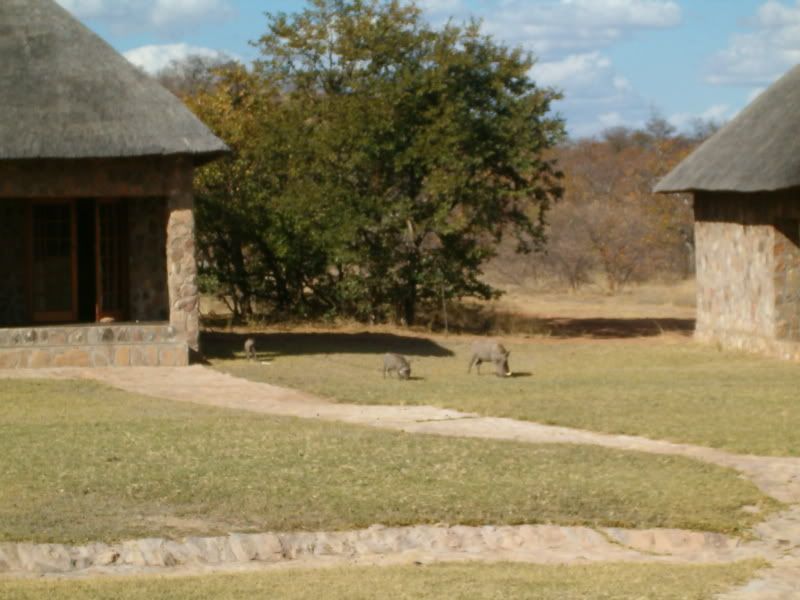 Bwanna outside my door 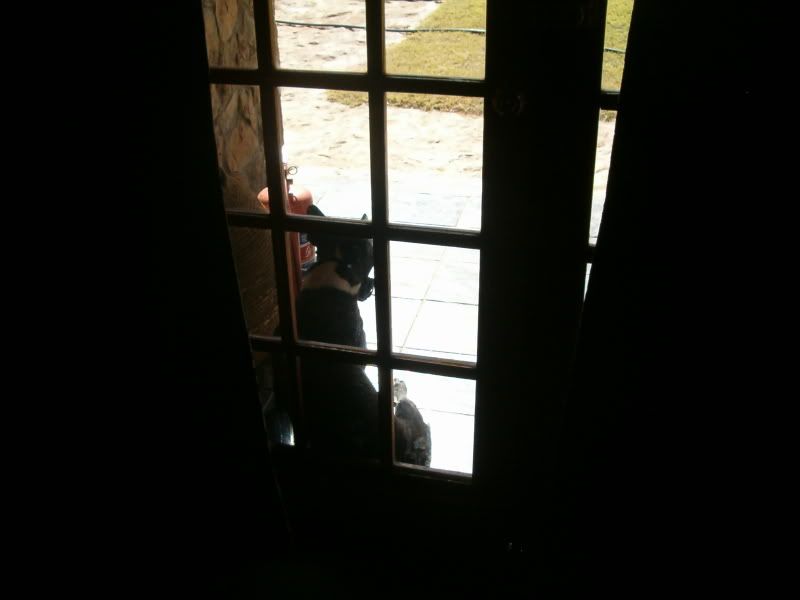 Eventually we drove off in search of impala. The wind had settled since the morning, but the game wasn’t as active. We came up on a pair of rams, and had a rather challenging stalk through the bush and up and down a kopje, but no luck. We kept going, and then saw some impalas ahead. Devlin drove on past them and then said “I know this herd, we call them the Baobob Bachelors.†There are a couple of really good rams in there. I’ll just drive past hem so the wind will be in our favor.†He drove a little further and then stopped. We got out and the chase was on. They kept moving on us, but they weren’t running, so we kept after them. Devlin picked out one, but his vitals were blocked by a tree. He set up the sticks and I got ready. After what seemed like hours but probably wasn’t even a full minute he finally walked into the clear maybe 85 yds away. I took aim and squeezed, and once again an animal dropped to the shot. Me, Devlin, and the Baobob Bachelor impala 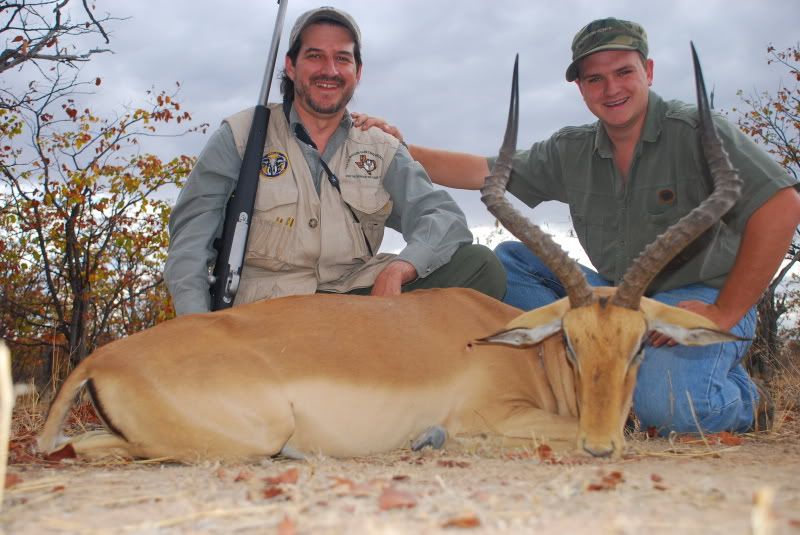 The Baobob tree that gave the group their name 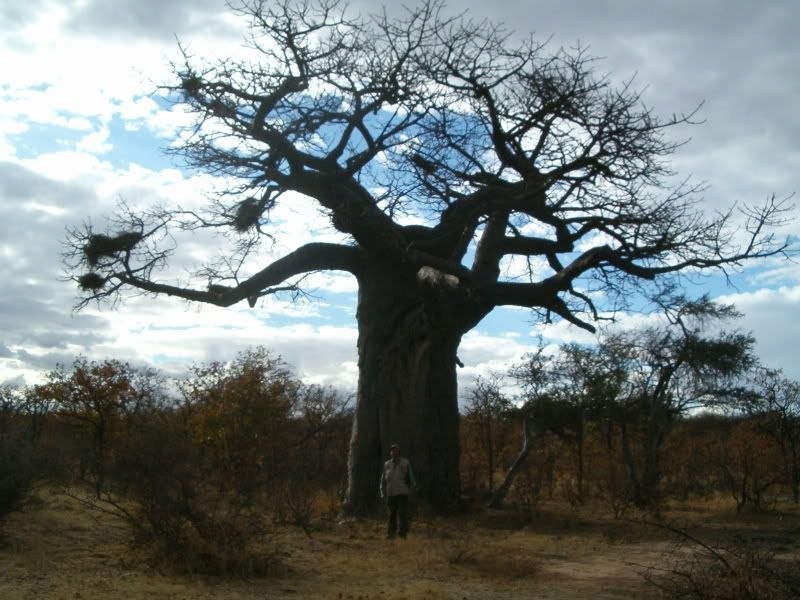 We walked up on him and this time I found the entrance wound in line with the foreleg, right where I’d aimed, it was a bit higher than intended, but it had taken out the spine in the shoulder, not the neck. I also noticed that this seemed to be a fairly good ram. We took the pictures and loaded him up, and headed back for the lodge. Along the way we saw some gemsbok at a distance, but never any wildebeest. I’d decided that mom would have to make do with a bushbuck backskin for a rug, and from a later conversation with her it sounds like she is even more excited about some leather goods from the hippo and/or buffalo. We returned to the lodge and had the best dinner I can remember having in Africa. After dinner I felt a sudden wave of exhaustion come over me. At the time I thought it was the adventures of the previous ten days catching up with me; little did I know that in some respects the adventure was just beginning. The next morning I had a final breakfast of coffee and rusks. I did some final rearranging of the bags so that I’d have room for airport gift shop purchases in my carry-on bag. The car was loaded up and we were ready to go with what should have been hours to spare. Then the first complication hit, the car wouldn’t start. Stephen tried tow starting it multiple times, but it wouldn’t turn over. Eventually Devlin got behind the wheel and he got it going on the first try. We then hit the road and stopped at a fuel station to top off the tank. Now with a full tank we prepared to get going again and once again it wouldn’t start. Luckily one of Stephens workers had another truck at this store at the time, and he helped us try to tow start it. I’m not sure how long this went on, but we weren’t getting it going. Finally Stephen gave up and we were towed into a mechanic’s shop. For Stephen’s sake I won’t say what was wrong, but he was pretty embarrassed once he found out what the problem was. Finally with a working car we were headed for the airport. Luckily we had left with some time to spare. Somewhere between Alldays and Warmbaths I realized that not only was I exhausted and cold, but my back and neck were aching. I began to think of tick bite fever for some reason. I knew we hadn’t really encountered any mosquitoes along the way, even in the Zambezi Valley, plus I’d been taking my lariam faithfully. I mentioned my symptoms to him, and said that if it didn’t go away or if I felt worse I’d hit up one of my colleagues for some doxycycline when I got home. He talked of how we hadn’t seen any mosquitoes, and then said the incubation period was 10days, and how there hadn’t been any ticks on the buffalo. Right about then I scratched my ankle and noticed a sore that looked like a cigarette burn, I showed it to him and he said “You’ve got tick bite fever all right. You must have gotten it in Natal, as a matter of fact that nyala was covered in them, and that was 10 days ago. I’ve had both malaria and tick bite fever before and tick bite fever was worse. You’re not getting on that plane without antibiotics.†We pulled off into Warmbaths and found a pharmacy. Stephen called a general practitioner friend of his, and he called in a prescription for me. We hit the road again, and seemed to have plenty of time to get me to the airport, and at any other time of day it would have been. Unfortunately we were hitting Pretoria at rush hour. The slowdown was eating up any spare time we had. Stephen even called Delta letting them know our situation they said they could keep the ticketing counter open a whopping extra 10 minutes. I suddenly had visions of being stuck in JoBerg an extra day or two and started thinking about contingency plans. I used Kathi Klimes as a travel agent, and I’d bought trip insurance, and started trying to remember where I kept their numbers. Somehow we made it to O.R. Tambo Airport with 5 minutes to spare before the ticketing counter was to close. Stephen told me to run to the gate and he’d catch up with me bringing the bags. I made it to the ticket counter, and there was one person in front of me still checking in. Somehow the line for security went very fast and I wasn’t held up there too much, but the line at passport control was ridiculous. Looking at my watch I had only 5 minutes to make it to the boarding gate before they closed it. I hopped over the metal barricades and went up to the agent at the end of the line and apologetically told him my predicament. With great politeness and genuine concern he said “Go to that desk, please.†If there is one thing which amazes me about South Africa is the politeness of the people; here I was, hopping the barricades to cut in front of about 150 people in line, and the official in charge of the line actually say “please†to me. I don’t think that would ever happen in America. After getting my passport stamped I took off running for my gate. I don’t remember how far it was, but I do know that as I got there my watch said it was exactly the time the gate was supposed to close boarding. I reached the gate and to my horror saw that the sign above it was listing a different flight. I knew that my flight hadn’t pulled away and in gasping breaths asked about my flight, certain that they’d let me board. As it turns out, my flight hadn’t even started boarding yet. With great relief I settled into a seat, and within a minute or two they did start boarding my flight. Winging our way back to Atlanta was a blur for me. I do remember that the lady in the seat next to me stayed into me and didn’t spill over into my seat, and that I was having a lot of fever sweats as I dozed and semi dozed over the Atlantic. As I think about it, I was probably the passenger causing someone unease on the flight back. Although I wasn’t crowding her space, who wants to sit next to someone who’s obviously ill even if they claim to be non-infectious? By the time I reached Atlanta I was feeling much better. Aches were gone, chills improved, but just feeling weak. After a 4 hr layover and a connecting flight to Wichita, only the weak feeling and a 1 hr drive home remained. I think getting the doxycyline in my system within 24 hrs of onset of symptoms made a big difference. I’ll continue to use lariam for malaria prophylaxis, but I’ll take some doxycycline with me as well in case of tick bite fever again. My leg in Atlanta Hatsfield Airport 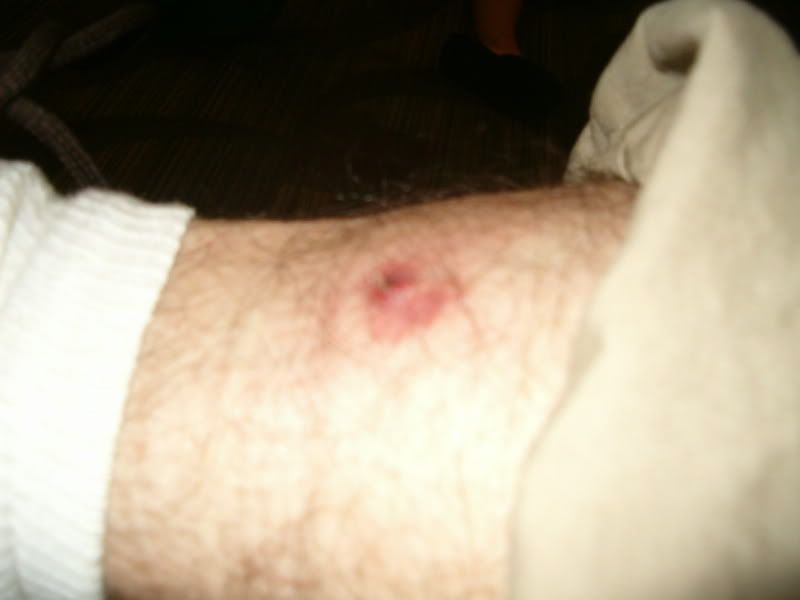 It felt great to be home again, but as I was settling in for the last of my fever dreams I was doing my pre-sleep-wide-awake dreaming of future hunts: the remaining 5 of the spiral nine, and trying to figure out how I can work more buffalo and bushbuck in to those hunts. Sitatungua, bushbuck , and buffalo in Zambia? Hunting the East African varieties of Sitatungua and bushbuck, complemented by lesser kudu and buffalo in Tanzania? Bongo and/or Lord Derby eland in Cameroon or CAR along with harnessed bushbuck and/or forest sitatungua? What might be available in Uganda if hunting there takes off? I think that the fantasizing about, researching, and planning for the safari approaches but never reaches the thrill of the actual trip. Those plans will remain fantasies or rather quasi plans until I pay for the taxidermy and shipping, and the overage from this trip and an expansion to the house just to hang the trophies. Maybe I can bribe the wife by letting her get new granite countertops in the kitchen at the same time? Caleb | |||
|
| One of Us |
GREAT report! I enjoyed every word, and most especially every picture! When you get bored with life, start hunting dangerous game with a handgun. | |||
|
| One of Us |
Great report, thank you for sharing it with us! Proud DRSS member | |||
|
| One of Us |
Great report. I really appreciated your sharing your conflicting emotions regarding the bushbuck hunt. When I was in Botswana, I shot a gemsbok just steps from the hunting vehicle. I had some trouble with it in retrospect, as I prefer to walk and stalk. It just ended up that way. I believe we are our experiences, and a bit of emotional conflict is good for us. | |||
|
| One of Us |
Thanks guys. If there was one part of the hunt I felt strange reporting, it was the bushbuck. I figured best just tell it like it was, and how I felt about it instead of making up some story about getting it at last light to explain the lack of sunlight in the pictures. Then again I'm sure everyone tells the truth all the time on the net, and even in the magazines. Caleb | |||
|
| one of us |
Very, very nice report Caleb. Besides the hunting information I think that you conveyed that feeling of unease that we often hear about conditions in Zim very well. Frank "I don't know what there is about buffalo that frightens me so.....He looks like he hates you personally. He looks like you owe him money." - Robert Ruark, Horn of the Hunter, 1953 NRA Life, SAF Life, CRPA Life, DRSS lite | |||
|
| Powered by Social Strata |
| Please Wait. Your request is being processed... |
|
 The Accurate Reloading Forums
The Accurate Reloading Forums  THE ACCURATE RELOADING.COM FORUMS
THE ACCURATE RELOADING.COM FORUMS  Hunting
Hunting  Hunting Reports - Africa
Hunting Reports - Africa  Natal to Zambezi to Limpopo
Natal to Zambezi to Limpopo

Visit our on-line store for AR Memorabilia

